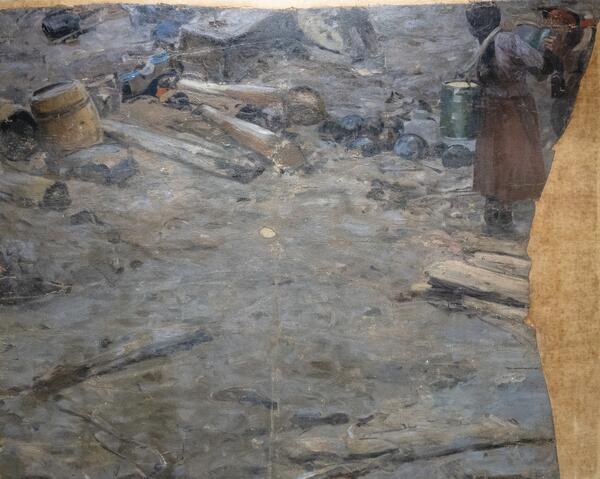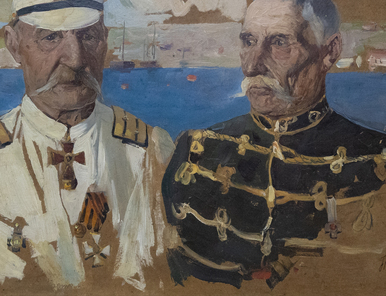The exhibition of the museum presents a surviving fragment of a large-scale canvas of Franz Roubaud’s panorama “Assault on June 6, 1855”, opened in Sevastopol in 1905, on the occasion of the 50th anniversary of the defense of Sevastopol in 1854-1855. The fragment depicts the first people’s sister of Mercy Dasha Sevastopolskaya, a participant in the city’s defense.
The artist showed her on the canvas from the back. The young woman is dressed in a lilac jacket, a dark red skirt and black high boots. She is wearing a black scarf tied at the back of her head. On the right shoulder there is a shoulder-yoke with two buckets.
In front of Dasha Sevastopolskaya, the artist depicted a soldier in a uniform gray great-coat with a white shoulder belt and red shoulder straps. The man can be seen waist-deep on the canvas: bent over, he’s drinking water from a bucket.
The real name of Dasha Sevastopolskaya is Daria Mikhailova. She was the daughter of Lavrenty Mikhailov, a sailor of the 10th Flipper Crew. On September 8, 1854 Darya Mikhailova bandaged the wounded under fire of the enemy for the first time on the field of the battle of Alma. Her cart with clean rags, bread, barrels of water and wine became the first dressing station on the front line in the Crimea, and she became the first Russian people’s Sister of Mercy.
Before the arrival of the Holy Cross Community of Sisters of Mercy, Mikhailova worked in the barracks and hospitals of the Marine Hospital on the North Side of Sevastopol. By decree of Nicholas I, she was the first among women in the Crimea to be awarded the gold medal “For diligence” on the Vladimir ribbon and 500 rubles in silver.
During the defense of Sevastopol, Daria Mikhailova was 27 years old. She married a common soldier of the 4th flipper crew, Vasiliy Maksimovich Khvorostov, and received 1000 rubles in silver, promised to her by Empress Alexandra Fedorovna. According to the recollections of old-timers, Mikhailova lived on the Korabelnaya Side. She died after 1911 and was buried in the Dock Ravine cemetery. The monument at her grave remained until the 1960s.
The panorama of Franz Roubaud was damaged during the bombing and fire during the second defense of Sevastopol on June 25, 1942. Only individual parts were saved from the fire — two-thirds of the painting canvas. The fragments were evacuated to Novosibirsk, where they were examined, cleaned of contamination, washed, and the paint layer was fixed.
The fragments were restored after the war. In December 1950, a special restoration commission was created and a team of restorers was approved to carry out the work, which recreated the Panorama on a new canvas. The panorama “Defense of Sevastopol in 1854-1855” was opened on October 16, 1954.
The artist showed her on the canvas from the back. The young woman is dressed in a lilac jacket, a dark red skirt and black high boots. She is wearing a black scarf tied at the back of her head. On the right shoulder there is a shoulder-yoke with two buckets.
In front of Dasha Sevastopolskaya, the artist depicted a soldier in a uniform gray great-coat with a white shoulder belt and red shoulder straps. The man can be seen waist-deep on the canvas: bent over, he’s drinking water from a bucket.
The real name of Dasha Sevastopolskaya is Daria Mikhailova. She was the daughter of Lavrenty Mikhailov, a sailor of the 10th Flipper Crew. On September 8, 1854 Darya Mikhailova bandaged the wounded under fire of the enemy for the first time on the field of the battle of Alma. Her cart with clean rags, bread, barrels of water and wine became the first dressing station on the front line in the Crimea, and she became the first Russian people’s Sister of Mercy.
Before the arrival of the Holy Cross Community of Sisters of Mercy, Mikhailova worked in the barracks and hospitals of the Marine Hospital on the North Side of Sevastopol. By decree of Nicholas I, she was the first among women in the Crimea to be awarded the gold medal “For diligence” on the Vladimir ribbon and 500 rubles in silver.
During the defense of Sevastopol, Daria Mikhailova was 27 years old. She married a common soldier of the 4th flipper crew, Vasiliy Maksimovich Khvorostov, and received 1000 rubles in silver, promised to her by Empress Alexandra Fedorovna. According to the recollections of old-timers, Mikhailova lived on the Korabelnaya Side. She died after 1911 and was buried in the Dock Ravine cemetery. The monument at her grave remained until the 1960s.
The panorama of Franz Roubaud was damaged during the bombing and fire during the second defense of Sevastopol on June 25, 1942. Only individual parts were saved from the fire — two-thirds of the painting canvas. The fragments were evacuated to Novosibirsk, where they were examined, cleaned of contamination, washed, and the paint layer was fixed.
The fragments were restored after the war. In December 1950, a special restoration commission was created and a team of restorers was approved to carry out the work, which recreated the Panorama on a new canvas. The panorama “Defense of Sevastopol in 1854-1855” was opened on October 16, 1954.



